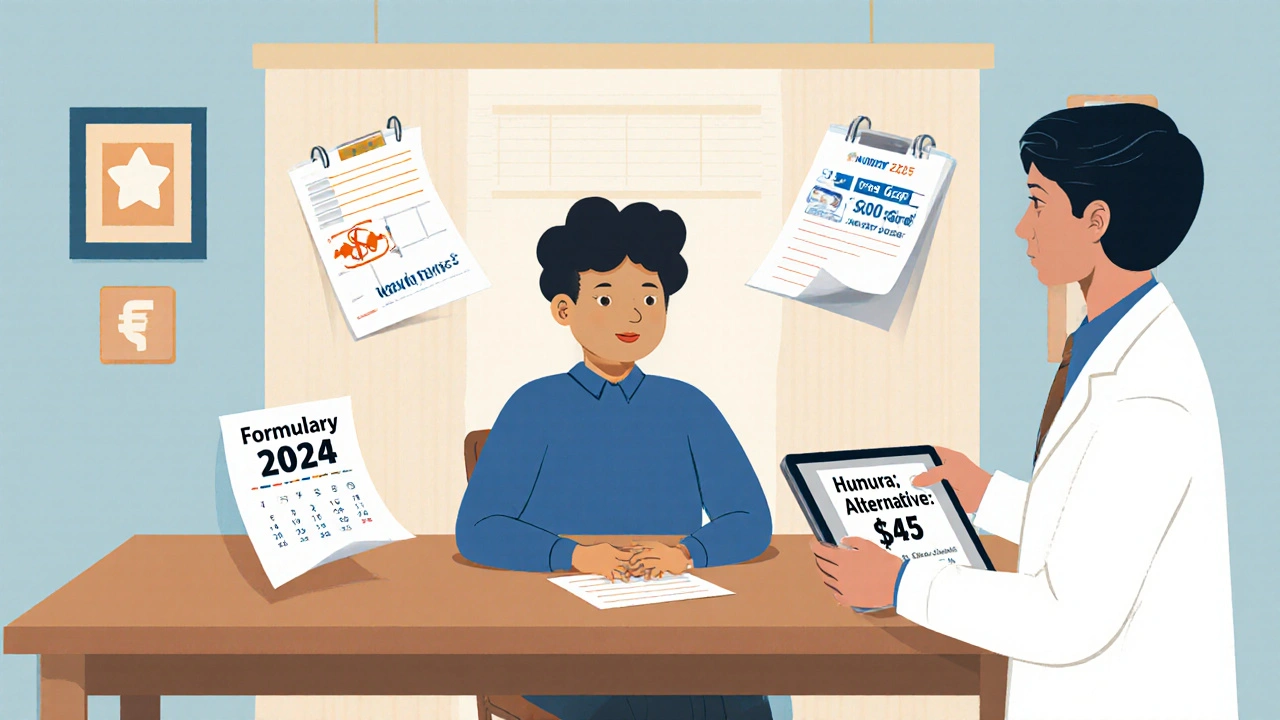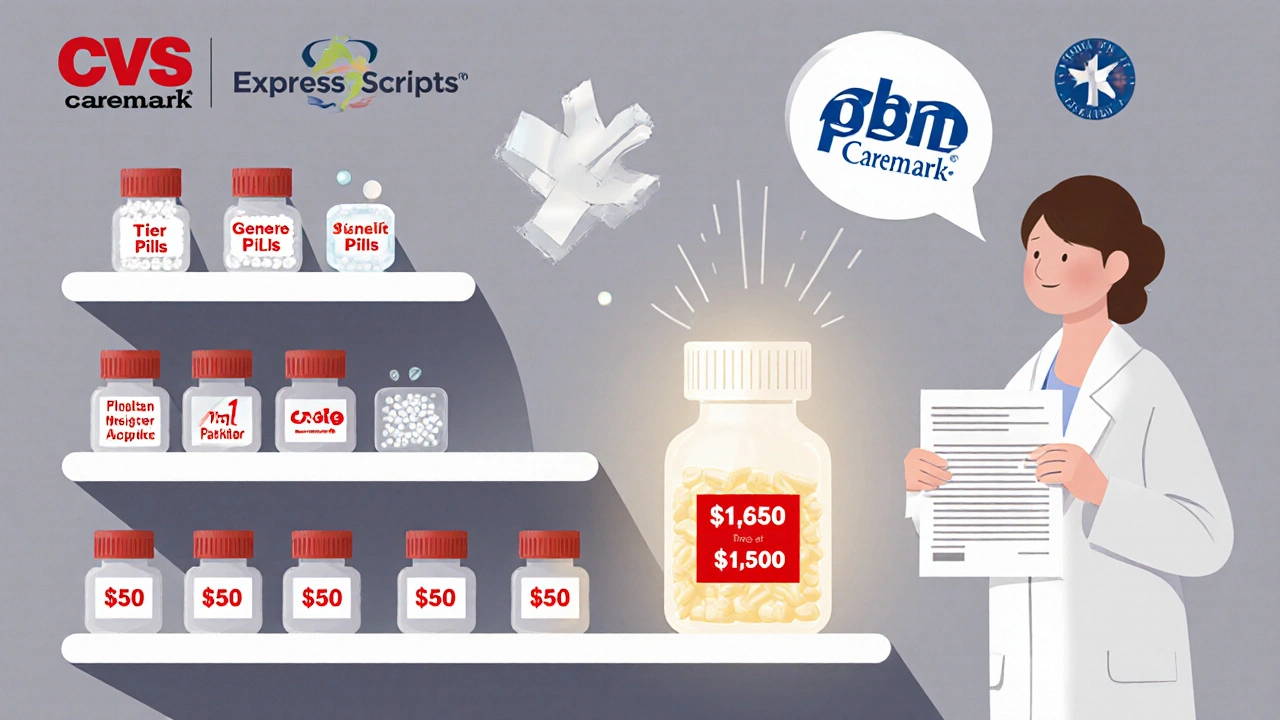What Is an Insurance Formulary?
An insurance formulary is simply the list of prescription drugs your health plan will pay for. It’s not a secret document buried in fine print-it’s the core reason your $50 pill suddenly costs $800, or why your doctor’s favorite medication isn’t covered at all. Every major health plan in the U.S., from Medicare Part D to employer-based insurance, uses a formulary to decide which drugs are covered, how much you pay, and under what conditions.
Formularies aren’t random. They’re built by Pharmacy Benefit Managers (PBMs) like CVS Caremark and Express Scripts, who negotiate with drugmakers to get rebates. In return, the drug gets placed on a preferred tier. The more rebate a drug offers, the higher it climbs on the list. That’s why some brand-name drugs cost less than generics-because the manufacturer paid the PBM to put it there.
The Four Tiers: How Your Costs Are Decided
Most formularies use a four-tier system to sort drugs by price and preference. The tier your medication lands on directly controls how much you pay at the pharmacy.
- Tier 1: Generics - These are the cheapest. You’ll typically pay $10-$15 per prescription. Most plans cover these with little to no restrictions.
- Tier 2: Preferred Brand-Name Drugs - These are brand-name medications the plan encourages. Copays are usually $40-$50. They’re often older drugs with proven safety and lower rebates than newer ones.
- Tier 3: Non-Preferred Brand-Name Drugs - These are more expensive brand-name drugs with little or no rebate. Expect $70-$100 per prescription. Many patients don’t realize their $80 pill is in this tier until they get the bill.
- Tier 4: Specialty Drugs - These are high-cost medications for complex conditions like cancer, MS, or rheumatoid arthritis. Instead of a flat copay, you pay a percentage-often 33%-of the total cost. That means a $5,000 drug could cost you $1,650 out of pocket in a single month.
That jump from Tier 1 to Tier 4 can mean a 300-500% increase in your cost. One patient on Humira saw their monthly bill go from $45 to $1,200 overnight when their plan moved the drug from Tier 2 to Tier 4. No warning. No notice.
Open, Closed, and Partially Closed Formularies: What’s the Difference?
Not all formularies are built the same. There are three main types:
- Closed Formularies - Cover only the drugs on the list. If your medication isn’t there, you pay full price unless you get an exception. About 65% of Medicare Part D plans use this model. It saves money for the insurer but creates big gaps for patients.
- Open Formularies - Cover nearly all drugs, even those not on the list. But they come with higher premiums-typically $18-$22 more per month. These are rare in Medicare but common in some employer plans.
- Partially Closed Formularies - A middle ground. They cover most drugs but exclude expensive or low-value ones. This is the most common type in the individual market.
Here’s the catch: a drug can be on Tier 2 in one plan and Tier 3 in another-even if they’re from the same insurer. A 2022 analysis found the same medication could cost $30-$60 more depending on the plan. That’s why comparing formularies during enrollment isn’t optional-it’s critical.
What Is Drug Substitution-and Why It Can Go Wrong
Substitution happens when a pharmacist swaps your prescribed drug for another one that’s chemically similar but cheaper. In 31 states, pharmacists can do this without asking your doctor, as long as the drugs are in the same therapeutic class. This is legal under state therapeutic substitution laws.
On the surface, it sounds smart: swap a $120 drug for a $40 alternative. But in practice, it can break treatment. A 2023 study in the American Journal of Managed Care found that 18% of prescriptions involved substitution-and 5-7% of patients with chronic conditions had treatment disruptions. One patient on a specific brand of seizure medication was switched to a generic. Within weeks, they had a seizure. The generic was technically equivalent, but their body reacted differently.
Not all substitutions are bad. For many people, switching from a brand-name statin to a generic version works perfectly. But for drugs with narrow therapeutic windows-like thyroid meds, blood thinners, or psychiatric drugs-even small differences can cause serious side effects.
Access Restrictions: Prior Auth, Step Therapy, and Quantity Limits
Even if your drug is on the formulary, you might still be blocked. Insurers use three main tools to control access:
- Prior Authorization - Your doctor must call or submit paperwork to prove you need this drug. The American Medical Association reports 82% of physicians face delays from this process. In 34% of cases, those delays caused serious harm.
- Step Therapy - You must try cheaper drugs first, even if they didn’t work before. For example, your doctor prescribes a new biologic for psoriasis, but the plan forces you to try three older, less effective drugs first.
- Quantity Limits - You can only get a 30-day supply, even if your doctor prescribed 90 days. This forces extra trips to the pharmacy and increases the chance you’ll run out.
These rules aren’t just paperwork-they’re delays that cost lives. CMS data shows the average approval time for a prior auth request is 7.2 business days. For someone needing cancer drugs or insulin, that’s dangerous.
How to Protect Yourself: Action Steps
You don’t have to accept surprise costs or treatment disruptions. Here’s what to do:
- Check your formulary during open enrollment - Medicare’s open enrollment runs October 15 to December 7. ACA plans run November 1 to January 15. Don’t wait until you refill your prescription.
- Use the insurer’s online tool - Most insurers have a formulary lookup tool. Type in your exact drug name, including the brand and generic. Don’t rely on memory.
- Ask about tier placement - If your drug is in Tier 3 or 4, ask your doctor if there’s a Tier 1 or 2 alternative with similar results.
- Request a formulary exception - If your drug isn’t covered, your doctor can file an exception. CMS approves 73.2% of these requests. But you need to act fast-some require documentation within 72 hours.
- Know your state’s substitution laws - If you live in one of the 31 states allowing pharmacist substitution, ask your pharmacist: “Will you substitute my drug without telling my doctor?” If they say yes, ask them to notify your doctor first.
Patients who spend just 15-20 minutes checking their formulary before choosing a plan save an average of $1,200 a year, according to the Patient Advocate Foundation.
What’s Changing in 2025?
The insurance landscape is shifting fast. Starting January 1, 2025, Medicare Part D will cap out-of-pocket drug costs at $2,000 per year. That’s a game-changer. It means insurers will have to restructure their formularies to avoid hitting that cap.
Also, by January 1, 2026, all Part D plans must show real-time drug costs and formulary status at the point of prescribing. That means your doctor’s electronic system will pop up a message: “This drug costs $1,200. Alternatives on formulary: $45, $80.”
More plans are also testing outcomes-based formularies. For example, if your diabetes drug keeps your HbA1c under 7.0%, your copay drops. It’s a shift from controlling costs to controlling results.

Real Stories, Real Costs
On Reddit, users share horror stories daily:
- “My Humira was covered. Then it wasn’t. No notice. I skipped doses for two months. Got hospitalized.”
- “Switched plans. My asthma inhaler went from $15 to $220. I had to buy it out of pocket.”
- “My doctor prescribed a drug. The pharmacy said it’s not covered. I called the insurer. They said it’s on the formulary. But only if you’ve tried four other drugs first.”
GoodRx’s 2023 survey found 68% of patients had a formulary issue in the past year. 42% skipped doses. 29% switched to less effective drugs. 18% quit treatment entirely.
But it’s not all bad. Humana’s Medicare plans score 4.3/5 for formulary clarity. Why? They built a cost estimator tool that predicts your monthly drug costs with 92% accuracy. That’s what transparency looks like.
Who Controls the Formulary-and Why It Matters
Most people think their insurance company controls the formulary. But it’s really the PBMs. CVS Caremark, Express Scripts, and OptumRx manage 92% of all prescription benefits in the U.S. They decide which drugs get on the list, which tier they’re on, and how much rebate they get.
That’s why the same drug can cost different amounts on different plans. It’s not about clinical value-it’s about who paid the most to get on the list. And because the top three PBMs control 83% of the market, they have enormous power to push prices up or down.
That’s why the Inflation Reduction Act forced insulin to cost no more than $35 a month. It was a direct response to PBM pricing power.
Final Takeaway: Know Your Formulary, Own Your Care
Your medication isn’t just a pill. It’s a product of a complex system designed to save money-not always to save lives. Formularies and substitution rules are real, and they directly affect whether you can afford to take your medicine.
Don’t wait for a surprise bill. Don’t assume your plan hasn’t changed. Check your formulary every year. Ask questions. Demand transparency. And if your drug gets pulled or switched without warning, file an exception. You have rights. Use them.
What is an insurance formulary?
An insurance formulary is a list of prescription drugs that your health plan covers. It determines which medications are available to you, how much you pay for them, and whether you need special approval to get them. Formularies are organized into tiers, with lower tiers costing less out of pocket.
Can my pharmacist substitute my prescription without telling me?
In 31 states, pharmacists are allowed to substitute a lower-cost drug within the same therapeutic class without notifying your doctor. This is called therapeutic substitution. While it can save money, it can also cause side effects or treatment failure, especially with drugs like thyroid meds, seizure medications, or blood thinners. Always ask your pharmacist if substitution will happen and request that your doctor be informed.
Why is my drug no longer covered?
Formularies change every year. Drugmakers may stop offering rebates, new generics may enter the market, or your insurer may switch Pharmacy Benefit Managers. Plans are required to notify you before changes take effect, but many don’t. Always check your formulary during open enrollment, even if you’re happy with your plan.
How do I get a drug that’s not on my formulary?
You can request a formulary exception. Your doctor must submit documentation showing why the non-formulary drug is medically necessary. Medicare Part D approves 73.2% of these requests. For urgent cases, you can request an expedited review, but approval rates drop to 38.5%. If denied, you can appeal.
What’s the difference between a generic and a brand-name drug?
Generics contain the same active ingredient as brand-name drugs and are required by the FDA to work the same way. But they may have different inactive ingredients, which can affect how the drug is absorbed. For most people, generics are safe and effective. For some-with conditions like epilepsy, thyroid disease, or mental health disorders-even small differences can cause problems. Always discuss this with your doctor before switching.
Are formularies the same across all insurance plans?
No. Medicare Part D plans must follow federal rules and cover at least two drugs per category. Employer plans often have tighter formularies with fewer brand-name drugs. Individual plans through Healthcare.gov are usually the most restrictive. Even within the same insurer, two different plans can have completely different formularies. Always compare formularies before choosing a plan.

